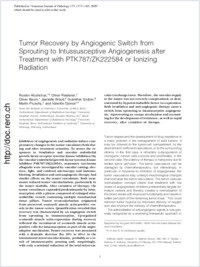Tumor recovery by angiogenic switch from sprouting to intussusceptive angiogenesis after treatment with PTK787/ZK222584 or ionizing radiation
- Hlushchuk, Ruslan Institute of Anatomy, University of Bern, Switzerland - Institute of Anatomy, University of Fribourg, Switzerland
- Riesterer, Oliver Department of Radiation Oncology, University Hospital, Zurich, Switzerland
- Baum, Oliver Institute of Anatomy, University of Bern, Switzerland
- Wood, Jeanette Novartis Pharma AG, Basel, Switzerland
- Gruber, Guenther Department of Radiation Oncology, University Hospital, Bern, Switzerland
- Pruschy, Martin Department of Radiation Oncology, University Hospital, Zurich, Switzerland
- Djonov, Valentin Institute of Anatomy, University of Bern, Switzerland - Institute of Anatomy, University of Fribourg, Switzerland
-
2009
Published in:
- American Journal of Pathology. - 2009, vol. 173, p. 1173-1185
English
Inhibitors of angiogenesis and radiation induce compensatory changes in the tumor vasculature both during and after treatment cessation. To assess the responses to irradiation and vascular endothelial growth factor-receptor tyrosine kinase inhibition (by the vascular endothelial growth factor tyrosine kinase inhibitor PTK787/ZK222854), mammary carcinoma allografts were investigated by vascular casting; electron, light, and confocal microscopy; and immunoblotting. Irradiation and anti-angiogenic therapy had similar effects on the tumor vasculature. Both treatments reduced tumor vascularization, particularly in the tumor medulla. After cessation of therapy, the tumor vasculature expanded predominantly by intussusception with a plexus composed of enlarged sinusoidal-like vessels containing multiple transluminal tissue pillars. Tumor revascularization originated from preserved α-smooth muscle actin-positive vessels in the tumor cortex. Quantification revealed that recovery was characterized by an angiogenic switch from sprouting to intussusception. Up-regulated α-smooth muscle actin-expression during recovery reflected the recruitment of α-smooth muscle actin-positive cells for intussusception as part of the angio-adaptive mechanism. Tumor recovery was associated with a dramatic decrease (by 30% to 40%) in the intratumoral microvascular density, probably as a result of intussusceptive pruning and, surprisingly, with only a minimal reduction of the total microvascular (exchange) area. Therefore, the vascular supply to the tumor was not severely compromised, as demonstrated by hypoxia-inducible factor-1α expression. Both irradiation and anti-angiogenic therapy cause a switch from sprouting to intussusceptive angiogenesis, representing an escape mechanism and accounting for the development of resistance, as well as rapid recovery, after cessation of therapy.
- Faculty
- Faculté des sciences et de médecine
- Department
- Département de Médecine
- Language
-
- English
- Classification
- Medicine
- License
-
License undefined
- Identifiers
-
- RERO DOC 12246
- DOI 10.2353/ajpath.2008.071131
- Persistent URL
- https://folia.unifr.ch/unifr/documents/301185
Statistics
Document views: 157
File downloads:
- pdf: 239
